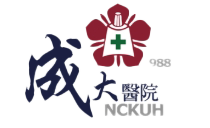Medical Quality Services
Leading Quality, Advancing Patient-Centered Care
Medical Quality Services
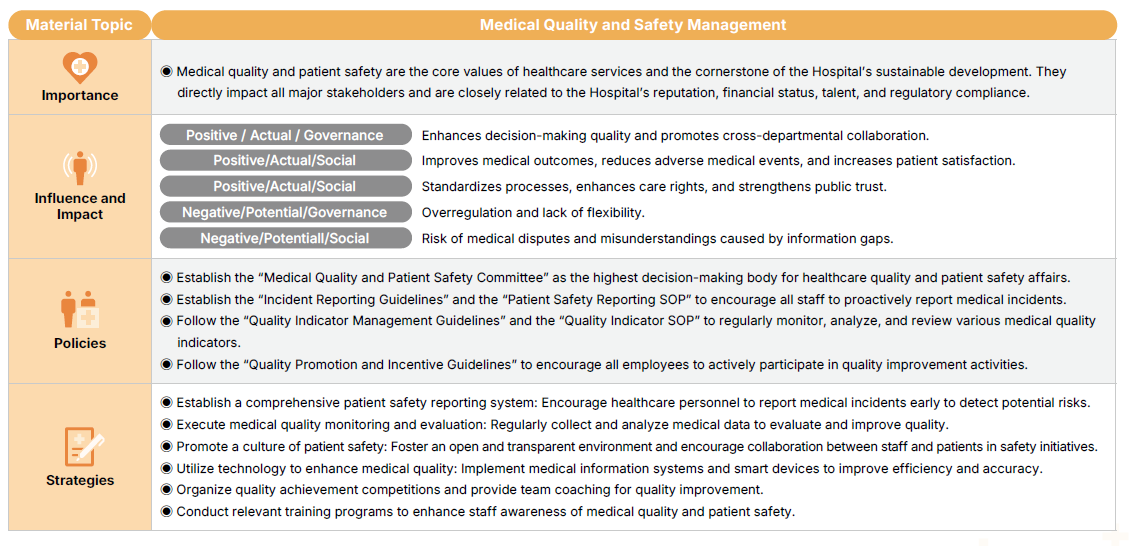
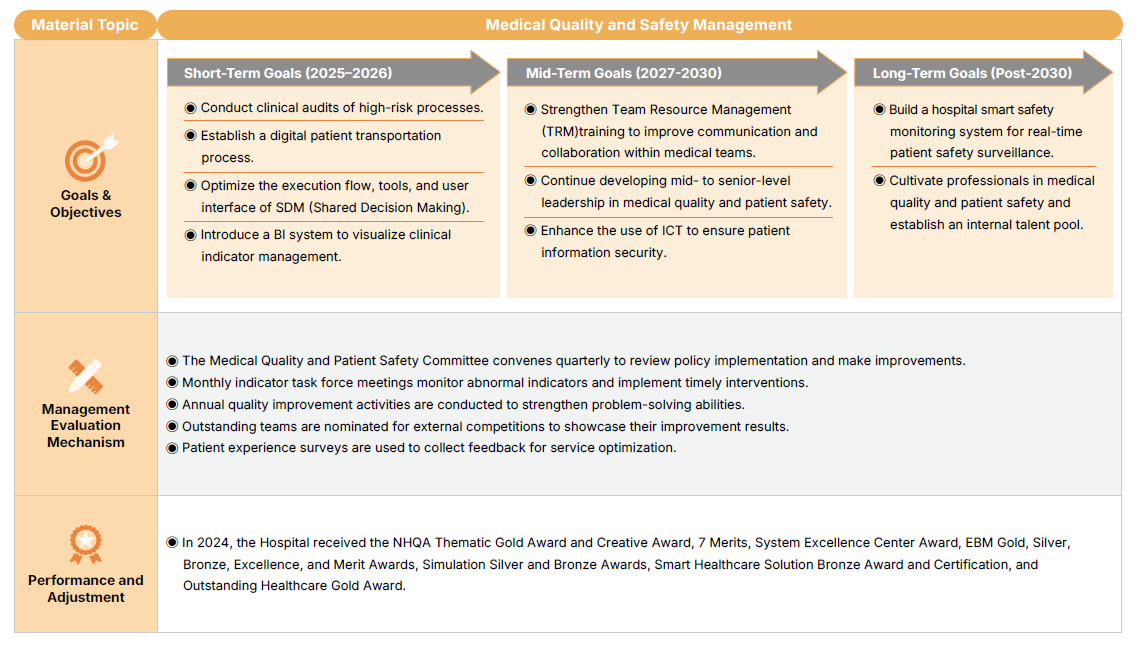
Cultivating a Quality Culture
-
Comprehensive Quality Management System
The Hospital prioritizes “Total Quality Management” as the core of its quality culture. In 2004, the Hospital established a dedicated “Quality Management Center,” and subsequently adjusted its organizational structure to integrate customer feedback management mechanisms. This ensures that quality management is no longer the responsibility of a single department but a shared goal throughout the Hospital. From the Superintendent’s Office meetings and medical affairs conferences to grassroots quality control promotion teams, a system is formed where policies are set top-down and issues are reported bottom-up, ensuring continuous quality improvement and effective resolution of complex issues.

-
Continuous Quality Improvement Momentum
“Continuous improvement” is another key feature of the Hospital’s quality culture. Through diverse mechanisms, staff at all levels are encouraged to actively participate in quality enhancement. For example, regular Quality Control Circle (QCC) and quality improvement project competitions are held. In addition, by defining and monitoring quality indicators, promoting root cause analysis Root Cause Analysis (RCA), and conducting strategic cross-team review meetings, the Hospital systematically identifies problems, formulates action plans, and evaluates effectiveness to ensure steady improvement in quality.
-
Close Collaborative Teamwork
The Hospital not only coordinates and resolves complex issues through cross-team meetings but has also established the “Ward Director System,” enabling ward directors to serve as primary leaders in overseeing medical quality and patient safety within their wards and actively participate in hospital accreditation and disease-specific certification. Furthermore, the collaboration between quality management consultant physicians and quality center specialists, as well as experience sharing and guidance with external medical institutions, highlights NCKU Hospital’s emphasis on collective intelligence and team efforts in promoting quality management.
-
Comprehensive Reward and Recognition Mechanism
To encourage staff to actively participate in quality improvement, the Hospital has established a comprehensive “reward and recognition” mechanism. In addition to internal QCC and quality improvement project competitions with monetary awards, employees are also encouraged to participate in national and international quality-related competitions, for which generous rewards and performance evaluation bonuses are offered, along with public recognition. These positive incentives effectively enhance employees’ engagement and commitment to quality improvement, allowing the quality culture to take root and flourish within the Hospital.
The Hospital’s quality culture is not only reflected in its rigorous systems and processes but is also deeply embedded in the daily work of every healthcare professional. Through total quality management, continuous improvement, a strong focus on education and training, embracing innovative learning, close teamwork, and a robust reward mechanism, NCKU Hospital has successfully created a model of excellence in healthcare quality and patient safety.
Distinctive Features in Promoting Healthcare Quality and Patient Safety
To continuously improve healthcare quality and ensure patient safety, the Hospital has implemented several distinctive initiatives. In terms of talent development, comprehensive training programs are designed for medical personnel at all levels—from frontline staff to management. These include cultivating the professional capabilities of quality consultant physicians, enhancing the quality management awareness of ward directors, training QCC facilitators in practical skills, developing RCA (Root Cause Analysis )seed instructors, and strengthening first-line supervisors’ emphasis on quality thinking. On the system and standardization front, the Hospital is committed to establishing well-defined and standardized operating procedures. Clinical audits are conducted to evaluate the implementation of medical practices. Active participation in external accreditations ensures alignment with international standards, while hospital evaluations drive continuous enhancement of medical service quality.
Internal momentum for continuous improvement is further fueled through competitions and certification programs. Incentive plans recognize outstanding quality improvement initiatives. QCC competitions foster teamwork and problem-solving abilities, departmental quality poster competitions encourage sharing of improvement outcomes, and external contests promote exchange and learning with other healthcare institutions.
Lastly, in response to trends in intelligence and innovation, the Hospital actively incorporates related applications—such as using smart healthcare support systems to enhance the efficiency and accuracy of clinical decision-making, introducing human factors engineering to optimize workflows and the medical environment, and establishing the Clinical Innovation and Research Center (CIC) to encourage healthcare personnel to generate and implement innovative solutions in healthcare quality and patient safety.
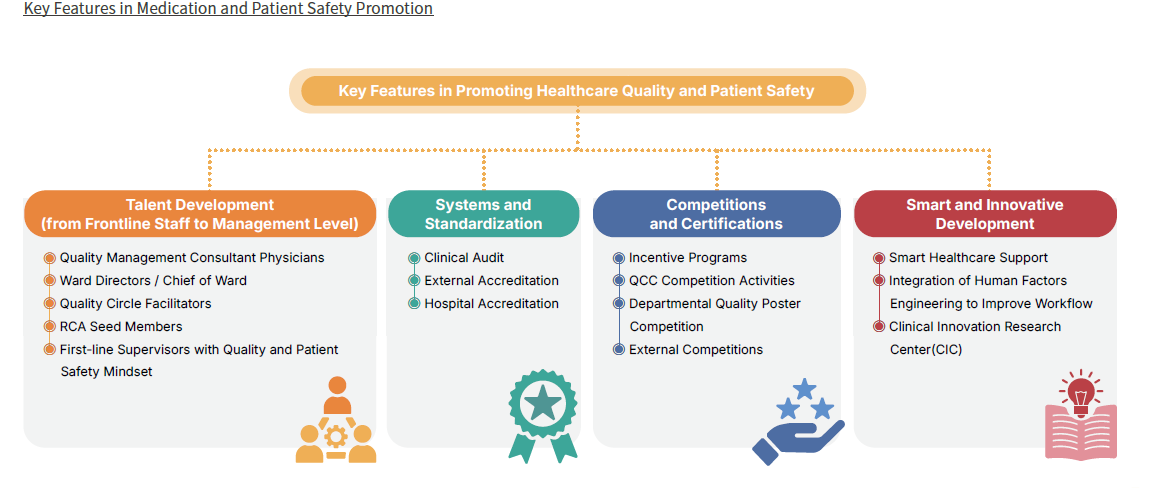
Healthcare Quality and Patient Safety Management Framework
The Hospital has established a comprehensive healthcare quality and patient safety management system encompassing 37 hospital-level committees, dedicated to ensuring excellence in healthcare quality and patient safety.
The hospital-level “Healthcare Quality and Patient Safety Committee” is the core unit responsible for formulating hospital-wide policies and directions related to healthcare quality and patient safety. The Superintendent serves as the convener and appoints a deputy convener, while the Director of the Quality Management Center acts as the executive secretary. The committee gathers input from a broad spectrum of professionals, comprising 44 members, including ex officio members such as first-line supervisors from each clinical department, the Department of Pharmacy, Department of Nursing, Department of Nutrition, Secretariat, Quality Management Center, Office of Medical Affairs, and Information Office. The remaining members are nominated by relevant departments and appointed by the Superintendent. The term of committee members is one year, and the list of members is updated every August.
The responsibilities of the “Healthcare Quality and Patient Safety Committee” include: formulating policies and directions for healthcare quality and patient safety; establishing an internal non-punitive incident reporting mechanism and risk management system; collecting and analyzing reports on healthcare quality and adverse events, and developing improvement plans; reviewing issues related to healthcare quality and patient safety management raised by various units and proposing improvement strategies; formulating implementation plans for healthcare quality and patient safety training; and reviewing the annual goals and strategic work plans for promoting healthcare quality and patient safety across the Hospital.
To ensure our Hospital’s medical quality and patient safety policies align with public needs, NCKUH invites external experts in quality improvement and patient safety to join the Medical Quality and Patient Safety Committee. In 2024, seven such experts served as Social Representatives, advocating for patient rights and offering valuable recommendations, thereby strengthening NCKUH’s initiatives in medical quality and patient safety.
Under the Medical Quality and Patient Safety Committee there are two key sub-groups:


The Hospital’s strategic objectives for quality are “Deliver High-Quality Care,” “Enhance Internal and External Customer Satisfaction,” and “Create a Safe Care Environment.” To centralize quality management, the Quality Management Center was established in January 1994, renamed the Quality Center in September 2015, and in September 2018 integrated the Public Affairs Office’s complaint handling to strengthen customer feedback management. The Quality Center comprises a Director, two Deputy Directors, dedicated and administrative staff, and clinical advisors appointed from senior attending physicians; Unit Chiefs are also assigned to facilitate cross-team collaboration. The Center is organized into five dedicated units:
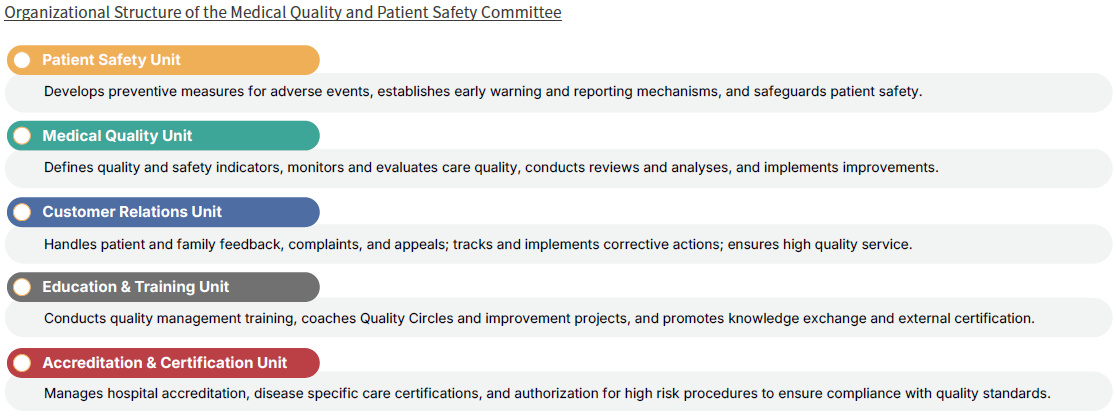
Fostering a Patient Safety Culture
-
Patient Safety Culture Survey
To promote a culture of patient safety, the Hospital conducts the “Patient Safety Culture Survey (PSC)” annually to proactively detect potential safety risks and serve as a forward-looking indicator for assessing and enhancing patient safety outcomes.
To cultivate a strong patient safety culture, departments are encouraged to actively implement internal improvement plans, including building teams that prioritize patient safety, establishing mechanisms that reward reporting and demonstrate tangible improvements, enhancing organizational safety climate through Team Resource Management (TRM) to foster effective interprofessional collaboration, strengthening staff well-being and workplace resilience, and enhancing the ability of healthcare personnel and the organization to respond to challenges.
Departments with outstanding performance in promoting patient safety culture are nominated to participate in the Joint Commission of Taiwan’s Patient Safety Culture Sharing Sessions to facilitate experience exchange and learning. In 2024, five individuals from the Departments of Obstetrics and Gynecology, Nutrition, Oral Medicine, and Medical Imaging were recommended to participate.
To strengthen the leadership of management in patient safety, the Hospital also assigns supervisors to attend courses in the JCT Patient Safety Culture Sharing Sessions and regularly conducts training sessions on Team Resource Management (TRM) and resilience to enhance teamwork, communication, and responsiveness among all medical personnel.
-
Patient Safety Reporting
The Hospital places high importance on and actively promotes the mechanism for reporting patient safety incidents. To encourage medical staff to report proactively, the Hospital’s Standard Operating Procedures for Patient Safety Reporting clearly stipulate that anonymous reporting is allowed, and the primary purpose of reporting is learning and improvement rather than punishment. For reports evaluated as having educational value or being able to substantially enhance medical quality, patient safety, and workplace safety, the Hospital provides an incentive of NT$500 per person. This is intended to foster a non-punitive organizational culture that encourages reporting, ensuring reported events receive appropriate attention and enabling learning from errors to improve the overall safety of medical care and the working environment. Regarding root cause analysis and improvement measures, in 2024 the Hospital conducted in-depth root cause analyses for five major patient safety incidents, resulting in multiple project improvement plans and a total of 27 systemic improvement measures. Among the reports deemed to have educational value in medical quality and patient safety, a total of 63 individuals received reporting incentives.
The Hospital, in accordance with the “Guidelines for Abnormal Event Reporting,” has formulated a comprehensive Standard Operating Procedure for patient safety reporting, clearly stipulating the reporting deadlines and specific procedures for various types of adverse medical events. Severity Assessment Code (SAC) is adopted to classify the severity of reported events. For SAC level 3–4 events, reviews and improvements are conducted by the respective departments. For SAC level 1–2 or sentinel events, an evaluation is carried out through a pre-established decision tree. If the root cause of the event is determined to involve systemic factors, a Root Cause Analysis (RCA) is further conducted, and corresponding improvement strategies are developed. The Hospital’s commitment to continuous improvement is evident in statistical data on the effectiveness of improvements made to reported patient safety events over the years.
In terms of personnel training and professional development, to enhance internal RCA capabilities, the Hospital proactively cultivated internal talent in 2024, training two medical personnel to become senior RCA analysts. Demonstrating a spirit of continuous learning and advancement in the management of patient safety incident reporting, the Hospital actively engages in experience-sharing and collaboration with external medical institutions, striving to continuously improve the quality and safety of medical care.
